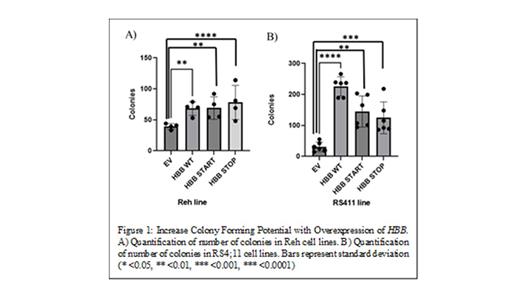Background: The prognosis for patients with relapsed acute lymphoblastic leukemia (ALL) remains suboptimal despite intensification of chemotherapy, immunotherapy and stem cell transplant. We and others have identified genetic and epigenetic alterations enriched at relapse that drive drug resistance and relapse. In our recent work mapping the epigenetic landscape of B-ALL, we discovered novel super-enhancers (SEs), or regions with increased H3K27 acetylation, enriched at relapse in a majority of patients, implicating a role in clonal evolution. One of these SEs was upstream of the β globin locus and lead to aberrant expression of hemoglobin beta subunit ( HBB) mRNA. HBB upregulation at relapse was also found in a large meta-analysis of gene expression data from pediatric diagnosis/relapse pairs. Of note, b globin is normally found in erythrocytes that interacts with other subunits to form functional hemoglobin.
We hypothesized that HBB upregulation in blasts plays a role in relapse and aimed to determine whether it leads to drug tolerance, an early recovery phenotype and/or increased clonal potential.
Methods: B-lineage REH, RS4;11 and 697 ALL cell lines were transduced with lentiviral vectors overexpressing either wild-type (WT) HBB or an empty vector (EV) control. Real time PCR was performed to confirm RNA expression and Western Blot analysis was performed to detect protein expression. We generated additional cell lines with a mutation in the translation start codon and another leading to a premature stop codon to unequivocally interrupt protein expression. The generated cell lines were then plated and evaluated for differences in apoptosis via Annexin V assay and proliferation, in response to chemotherapeutic agents commonly used in the treatment of ALL. Clonogenic growth in vitro was also assessed using MethoCult TM media.
To test the possibility that HBB acted in generating a persistor cell phenotype, cell lines were placed in mercaptopurine and prednisone for 10-14 days at two different concentrations and counted throughout drug exposure and for an additional 10-14 days following removal of drug.
Results: We did not observe significant differences in chemosensitivity to various chemotherapies used in the treatment of B-ALL. However, we did observe less cells undergoing apoptosis in HBB expressing cells compared to control following prolonged treatment with 6-mercaptopurine, suggesting an increase in a small population of drug tolerant cells. However, this did not result in a difference in recovery time following removal of the drug. We also demonstrated that β globin overexpression led to increased clonal growth in methylcellulose compared to control (Fig. 1A, REH) and this observation was replicated in a second cell line (Fig. 1B, RS4;11).
While we confirmed mRNA expression, we were not able to confirm protein expression by Western blot or by immunoprecipitation. We therefore hypothesized that b globin mRNA, rather than protein, mediates the observed increase in clonal growth. Interestingly, we observed the same phenotype of increased clonal growth (Fig. 1) in mutated cell lines, suggesting a catalytic role for β globin RNA in expanding a leukemia stem cell population.
Conclusions: The increased clonal potential upon overexpression of HBB could be indicative of the ability to reconstitute a tumor from a small subpopulation following treatment. Additionally, our data suggests that protein is not required for increased clonal growth leading us to hypothesize that catalytic RNA is responsible. We are also currently analyzing RNAseq data from the cell lines and will compare differential gene expression between the empty vector and HBB expressing cells to discover downstream pathways impacted by HBB. We will be testing this hypothesis further by performing limiting dilution analysis in an immunocompromised mouse model (with David Teachey, Children's Hospital of Philadelphia).
Disclosures
Raetz:Bristol Myers Squibb: Membership on an entity's Board of Directors or advisory committees; Pfizer: Research Funding.


This feature is available to Subscribers Only
Sign In or Create an Account Close Modal